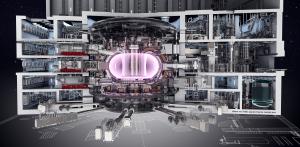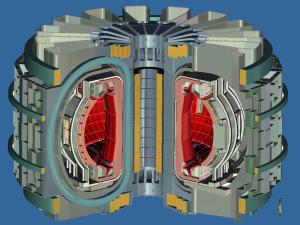60 years of progress

Fusion research has increased key fusion plasma performance parameters by a factor of 10,000 over 60 years; research is now less than a factor of 10 away from producing the performance needed for a fusion power plant.
Following the first fusion experiments in the 1930s, fusion physics laboratories were established in nearly every industrialized nation. By the mid-1950s "fusion machines" were operating in the Soviet Union, the United Kingdom, the United States, France, Germany and Japan. Through experiments on these machines, scientists' understanding of the fusion process was gradually refined.
The first small-size devices (1950s-1970s) were basic devices without sophisticated control systems and technology, but they demonstrated that high temperature plasmas could be generated and that energy could be confined. New plasma phenomena such as anomalous transport, instabilities and disruptions were uncovered during these first experiments. Scaling laws indicated that energy confinement could be increased in larger devices with higher magnetic fields.
A major breakthrough occurred in 1968 in the Soviet Union. Researchers there were able to achieve temperature levels and plasma confinement times—two of the main criteria to achieving fusion—that had never been attained before. The Soviet machine was a doughnut-shaped magnetic confinement device called a tokamak.
From this time forward, the tokamak configuration was to become the dominant concept in fusion research, and tokamak devices multiplied across the globe.
Milestones around the world
Medium-sized tokamaks in the 1980s introduced the extensive use of auxiliary heating techniques. The addition of the divertor demonstrated improved confinement; wall conditioning techniques were also introduced. The ASDEX Tokamak achieved high confinement mode for the first time in 1982. A new generation of larger tokamaks—JET (Europe), JT-60 (Japan), TFTR (US), T-15 (Soviet Union)—were built to study plasmas in conditions as close as possible to those of a fusion reactor, and regularly upgraded based on advances in fusion science. New features such as superconducting coils, deuterium-tritium operation, and remote handling were introduced. In 1991, JET achieved the world's first controlled release of fusion power.
Steady progress has been made since in fusion devices around the world. The Tore Supra tokamak in France holds the record for the longest plasma duration time of any tokamak: 6 minutes and 30 seconds. The Japanese JT-60 achieved the highest value of fusion triple product—density, temperature, confinement time—of any device to date. US fusion installations have reached temperatures of several hundred million degrees Celsius. New facilities came on line in the 2000s in China (EAST) and Korea (KSTAR).
Since the 2000s, tokamak programs in the ITER Members have re-oriented their scientific programs or modified their technical characteristics to act either partially or totally in support of ITER operation. These machines are conducting R&D on advanced modes of plasma operation, plasma-wall interactions, materials testing, and optimum power extraction methods, contributing to the success of ITER and the design of the next-phase device. (Find these devices and laboratories in our International Tokamak Research section.)
Looking ahead
Today, magnetic confinement fusion science is on the cusp of an exciting threshold: the long sought-after plasma energy breakeven point (Q=1), which describes the moment when plasmas in a fusion device release at least as much energy as is required to heat them. Where JET succeeded in generating 16 MW of fusion power for 24 MW of heating power (a Q ratio of 0.67), ITER is designed to pass plasma energy breakeven and produce 500 MW of fusion power for 50 MW consumed by the heating systems (Q≥10).
Research is also advancing on alternative concepts such as the stellarator (a different magnetic confinement configuration) and inertial confinement (laser fusion). In late 2022, researchers at the National Ignition Facility at the Lawrence Livermore National Laboratory in California achieved Q=1.5, improving significantly over previous attemps. Many challenges remain on the road to designing a commercial energy plant, however, as the engineering is generally considered to be even more challenging than magnetic confinement fusion.
Also of note: in recent years, the private fusion landscape has seen a drastic increase in both companies and investments. This newfound private interest in fusion has been attributed to a multitude of factors, including efforts to develop enabling materials and new approaches that could make fusion devices more realistic at smaller scale or with different designs; the path paved by ITER in designing, fabricating, delivering, and assembling components; recent successes at public laboratory test centres around the world; and the sense of urgency globally to identify alternative sources of clean power.







